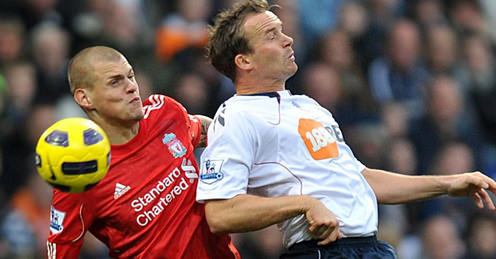When considering how Liverpool have struggled in the last two months following their last gasp defeat to Arsenal at Anfield, a look at the statistics makes one thing very clear: their opponents have been much more effective in front of goal recently.
The following graph shows how many shots per game (SPG) both Liverpool and their opponents have averaged as the season has progressed:
 For the season as a whole, the Reds average 4.14 SPG more than their opponents; whilst Liverpool’s SPG has only dipped below 13.00 once in the last twenty-six league games, their opponents SPG is currently at just 8.25, the joint lowest it has been since the fourth game of the season (at which point the small sample size can create far greater fluctuations in any case).
For the season as a whole, the Reds average 4.14 SPG more than their opponents; whilst Liverpool’s SPG has only dipped below 13.00 once in the last twenty-six league games, their opponents SPG is currently at just 8.25, the joint lowest it has been since the fourth game of the season (at which point the small sample size can create far greater fluctuations in any case).
Since Liverpool’s seventeenth league game (away at Wigan Athletic), their opponents’ SPG has been on a generally downward trend. So why have the results been worse? The following graph will explain why; it shows how the shot conversion percentage (SCP) for the Reds and their opposition has fluctuated across the season:
This shows you all you need to know when trying to assess Liverpool’s woes of late. Since their 20th match, a 3-0 defeat at Manchester City, the teams playing Liverpool have collectively been converting a higher percentage of their shots than the Reds have themselves, and the gap has continued to widen overall ever since.
Prior to that game, Liverpool earned 1.79 points per game (which, don’t forget, has been enough for a top four finish in every one of the previous sixteen seasons). From the start of that game onward, only 0.88 points per game have been earned by the Pool, which would almost certainly lead to relegation if carried across a whole season.
So why this massive change in defensive fortunes? To my mind the most likely explanation is that whilst Liverpool have been giving away generally fewer chances lately, they have most likely been better ones; the striker may have had more space and time to take his shot for instance, which obviously increases his chances of finding the back of the net.
A look at the teamsheets for this season emphasised this point even more; the above mentioned 3-0 defeat at the Etihad Stadium was the last in a run of eleven consecutive league games where (what I consider to be) Liverpool’s best back four of Johnson, Skrtel, Agger and Enrique all started together.
The 0-0 draw at Wigan mentioned above saw the lowest conversion rate of the season (since the 4th game), and that was the eighth game that the above back four started together. It can’t be coincidence that the figures went down with a settled back four, and have risen since it was disbanded (though of course the absence of Lucas Leiva, who covers the space in front of the defence so majestically, has obviously been keenly felt too).
There have been four further games since the Manchester City match where the frst choice back four have started, and the overall figures make for stark reading: in fifteen games where that back four have started, Liverpool’s opponents have converted 9.89% of their shots; for the remaining twenty-one games, it has been 11.16%. In a low scoring sport like football, an increase of 1.27% can, and has, proved costly.
Whilst the injury troubles of Daniel Agger and Glen Johnson are well documented, and Jose Enrique has lost his impressive early-season form in recent months, it does seem that keeping those three alongside Martin Skrtel as much as possible next season may well improve Liverpool’s defensive record significantly.
Originally published: BassTunedToRed.com


